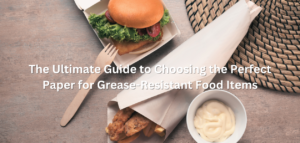Starting a new restaurant or cloud kitchen is an exciting venture, and as you plan your menu, staff, and space, don’t overlook a crucial aspect: your packaging. Sustainable packaging isn’t just a trend—it’s an essential part of running a modern, responsible business. Here’s a handy guide to help you navigate the world of eco-friendly packaging and make choices that align with both your budget and your brand’s values.
What Is Sustainable Packaging and Why Is It Important?
Sustainable packaging refers to materials and processes that reduce environmental impact. This can mean using biodegradable, compostable, or recyclable materials that minimize waste and conserve resources.
For restaurant owners, this is especially important because:
- Customers care: Many consumers actively seek out businesses that prioritize sustainability.
- Regulations are changing: Many cities are adopting stricter laws on single-use plastics, so switching to eco-friendly packaging now can future-proof your business.
From our experience working closely with several restaurant startups, we’’ve seen firsthand how customers react when they realize you genuinely care about the environment. The feedback is always remarkable. It does more than just boost your brand’s image—it creates a deeper connection with customers and fosters long-term loyalty.
What Are the Types of Sustainable Packaging Available?
There are several options available for eco-friendly packaging materials, each with its own benefits:
1. Biodegradable Packaging
- Breaks down naturally over time.
- Common materials: plant-based plastics, paper, and bagasse (a byproduct of sugarcane).
- Best for: Takeaway containers, food wraps, takeaway boxes and cups.
2. Compostable Packaging
- Not only breaks down but also contributes to soil health.
- Common materials: cornstarch containers, bamboo, and compostable plastic.
- Best for: Salad bowls, cutlery, and to-go containers.
3. Recyclable Packaging
- Can be processed and reused, reducing the need for virgin materials.
- Common materials: paper, cardboard, aluminum, and certain plastics.
- Best for: Shipping boxes and wraps
Each of these options can be tailored to different food types. For example, if your cloud kitchen specializes in soups, you might want to opt for biodegradable paper containers lined with a compostable film to prevent leaks.
Assessing The Right Packaging Needs For Your Menu
Choosing packaging is not just about sustainability; it’s also about practicality. The packaging must keep your food fresh, hot or cold as needed, and intact during delivery.
Here’s how you can match your menu to your packaging:
- Hot Foods: Opt for insulated, compostable containers to maintain heat without affecting the flavor.
- Cold Foods: Use recyclable or biodegradable containers that are moisture-resistant to prevent sogginess.
- Liquid Items: Choose leak-proof options like PLA coated paper containers or bagasse bowls for soups and sauces.
- Delicate Items: For items like pastries or delicate sandwiches, sturdy recyclable boxes or biodegradable trays can protect against damage during transit.
Your packaging isn’t just a vessel for your food; it’s part of the customer experience. Good packaging should:
- Maintain Food Quality: Ensure your food stays fresh and appetizing until it reaches the customer.
- Be User-Friendly: Easy-to-open packaging and clear labeling can enhance customer satisfaction.
Picture this: you order a beautifully crafted bubble tea, but by the time it arrives, the cup is squished, and the box is leaking. Not exactly the experience you were hoping for, right? This is why investing in the right packaging matters so much. We helped one of our clients, a Bubble Tea Cafe in Chennai, switch to recycled cardboard holders for their drinks to give them that extra protection during deliveries. After that simple change, customer complaints dropped dramatically. Sometimes, a small adjustment in your packaging can lead to big improvements in customer satisfaction.
Cost Considerations and Budgeting
Sustainable packaging can sometimes be more expensive than traditional options. Here are some tips to balance cost and sustainability:
- Start small: You don’t need to overhaul all your packaging immediately. Begin by using sustainable options for your most popular items.
- Bulk buying: While this may seem a big investment at first glance, consolidating your packaging and ordering bulk can bring down per-unit costs.
- Simplify designs: Custom designs can increase costs. Stick to simple, branded logos to keep it affordable.
- Focus on high-impact items: Target the packaging that customers see the most (like takeout containers or coffee cups) and make those sustainable first.
Common Mistakes to Avoid When Choosing Sustainable Packaging
Choosing the right packaging isn’t just about aesthetics; functionality matters just as much. One common mistake is prioritizing style over function. Some eco-friendly packaging may look great but might not hold up during transport, leaving you with soggy or damaged food. It’s essential to test your packaging to ensure it performs well in real-world conditions before committing to a large order.
Another pitfall is ignoring customer convenience. Packaging should be easy to open, resealable if necessary, and designed to keep food fresh for as long as possible. If your customers find the packaging frustrating to use, it can negatively impact their overall experience with your brand.
Testing materials before a full-scale rollout is another critical step. You want to be sure that your food maintains its quality and presentation, whether it’s being eaten immediately or after a delivery.
Balancing Functionality and Sustainability
At the end of the day, the key to successful packaging lies in finding the right balance between functionality and sustainability. It’s not enough to have packaging that’s eco-friendly—it also needs to protect your food, enhance the customer experience, and align with your brand.
As a startup, especially in the food industry, this balance is crucial to both your short-term success and long-term growth. The good news is that sustainable packaging doesn’t have to be an all-or-nothing decision. You can take small steps, adjust as needed, and scale up your efforts over time.
And if you’re feeling stuck or unsure about what direction to take, that’s where we come in. With years of experience helping restaurants and cloud kitchens find the right packaging solutions, we’re here to help you navigate your options. Whether you’re looking for eco-friendly materials, functional designs, or cost-effective solutions, we can guide you every step of the way.
If you’re ready to make your packaging as great as your food, Ritika Ventures Packaging can help. Let’s work together to find the best solution for your business—one that’s good for your customers, your budget, and the planet.




